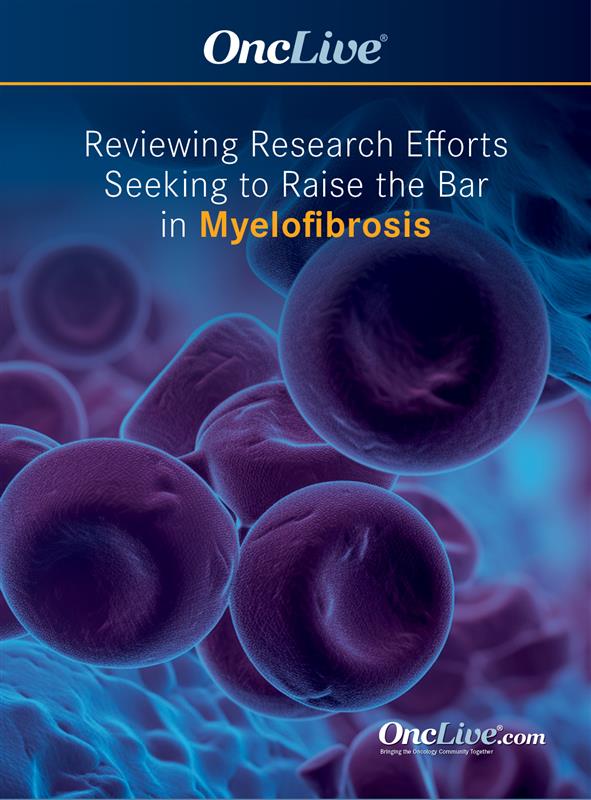News
Article
Investigators Set to Explore Selinexor Monotherapy or Plus Ruxolitinib in JAK Inhibitor–Naive Myelofibrosis
Author(s):
Selinexor is under investigation as monotherapy and in combination with the JAK inhibitor ruxolitinib in patients with JAK inhibitor–naive myelofibrosis.
John O. Mascarenhas, MD

The XPO1 inhibitor selinexor is under investigation as monotherapy in patients with JAK inhibitor–naive myelofibrosis and moderate thrombocytopenia in the phase 2 XPORT-MF-044 (NCT05980806) and in combination with the JAK inhibitor ruxolitinib (Jakafi) in the phase 3 XPORT-MF-034 (NCT04562389) trials, respectively.
Myelofibrosis is associated with underlying biological characteristics including cytokine production and inflammation; aberrant bone marrow and blood differentiation; extramedullary hematopoiesis; and bone marrow fibrosis.1 JAK inhibitors provide limited efficacy against the underlying drivers of myelofibrosis, and often do not prevent disease progression or induce disease modification, such as alterations in bone marrow fibrosis or inflammation.2 Furthermore, treatment options are limited for patients with thrombocytopenia who often receive suboptimal doses of ruxolitinib that results in suboptimal spleen and/or symptom reduction.
Selinexor is an oral XPO1 inhibitor with anti-inflammatory and pro-apoptotic properties that may affect JAK and non-JAK pathways.3 “Mechanistically, [the drug] makes a lot of sense,” John O. Mascarenhas, MD, said in an interview with OncLive®. “[Selinexor] hits a lot of the pathways that are relevant to the disease, including XPO1 inhibition and the proteins that exist within the JAK/STAT signaling pathways. Related pathways are activated, [as well as] non-signaling pathways, such as p53, which are important players in mediating myelofibrosis CD34-positive cell survivability.” Mascarenhas is a professor of medicine at the Icahn School of Medicine at Mount Sinai, director of the Center of Excellence for Blood Cancers and Myeloid Disorders, and a member of the Tisch Cancer Institute, where he directs the Adult Leukemia Program and leads clinical investigations within the Myeloproliferative Disorders Program.
The phase 1 analysis of the XPORT-MF-034 trial showed that 79% of patients (n = 11/14) with JAK inhibitor–naive myelofibrosis who received selinexor at 60 mg plus ruxolitinib achieved spleen volume reduction of at least 35% (SVR35) from baseline, and 58% of patients (n = 7/12) achieved total symptom score reduction of at least 50% (TSS50) from baseline at week 24.4 The most common adverse effects (AEs) observed in the study were nausea (78.6%), fatigue (57.1%), anemia (64.3%), and thrombocytopenia (64.3%), most of which were grade 1/2. Two patients experienced treatment-related AEs leading to treatment discontinuation, 1 with thrombocytopenia and 1 with neuropathy.
“There is expected toxicity with this drug, potential gastrointestinal [GI] toxicity, dysgeusia, asthenia, and myelosuppression,” Mascarenhas noted. “Those are things we’ll have to keep an eye on that could be vulnerabilities of the drug. But the initial data look encouraging from a balancing act of deep responses, safety, and tolerability.”
XPORT-MF-044 and XPORT-MF-034
The 2-arm, sequential, multicenter, open-label, phase 2 XPORT-MF-044 trial is evaluating the efficacy and safety of selinexor monotherapy followed by an optional JAK inhibitor add-on medication in 58 to 118 patients with JAK inhibitor–naive myelofibrosis with moderate thrombocytopenia.3 The multicenter, randomized, double-blind, placebo-controlled, global phase 3 component of XPORT-MF-034 is evaluating the efficacy of selinexor plus ruxolitinib in 300 to 450 patients with JAK inhibitor–naive myelofibrosis.5
“[Selinexor] has activity as a monotherapy, [but] I don’t think that’s the best strategy for the drug to be developed,” Mascarenhas emphasized. “For most drugs on the near horizon that are being developed, [they need to be developed] in combinations. That’s where you get the best balance between efficacy and safety…Different strategies can be complementary, where you might start with 1 [drug], then you might pivot to salvage with another drug. Ruxolitinib might end up being the backbone of these combination approaches.”
Across both trials, patients at least 18 years of age will be included if they have primary myelofibrosis, post-essential thrombocythemia myelofibrosis, or post-polycythemia vera myelofibrosis; measurable splenomegaly, defined as spleen volume of at least 450 cm3 by MRI or CT scan; active myelofibrosis symptoms, defined as the presence of 2 or more symptoms with a score of at least 3 or a total score of at least 10 using the Myelofibrosis Symptom Assessment Form v4.0 at screening; a Dynamic International Prognostic Scoring System (DIPSS) score of intermediate-1 with symptoms, intermediate-2, or high-risk; and an ECOG performance status of 0 to 2.3,5 In XPORT-MF-044, patients must have platelet counts of 50 to less than 100 x 109/L without platelet transfusion, whereas in XPORT-MF-034, platelet counts must be at least 100 x 109/L without platelet transfusion.
Patients will be excluded if they are a candidate for stem cell transplantation; have greater than 10% blasts in the peripheral blood or bone marrow; have received previous treatment with JAK inhibitors for myelofibrosis; have previously received selinexor or other XPO1 inhibitors; have impaired GI function or GI disease that could significantly alter selinexor absorption; have undergone major surgery less than 28 days before day 1 of cycle 1; have undergone prior splenectomy or splenic radiation within 6 months before day 1 of cycle 1; or are unable to tolerate 2 forms of antiemetics.
In XPORT-MF-044, patients will initiate selinexor treatment at either 60 mg once weekly (n = 29) or 40 mg once weekly (n = 29) and will be required to receive supportive care in the form of dual antiemetics for nausea prophylaxis during the first 2 cycles.3 Patients who do not reach an SVR of over 10% at week 12 or over 35% at week 24 will receive an optional JAK inhibitor add-on medication. These patients will receive ruxolitinib if their platelet counts are at least 50 x 109/L and their hemoglobin levels are greater than 10 g/dL or less; pacritinib (Vonjo) if their platelet counts are less than 50 x 109/L; or momelotinib (Ojjaara) if their platelet counts are at least 50 x 109/L and their hemoglobin levels are less than 10 g/dL.
The primary end point of XPORT-MF-044 will be SVR35 at week 24. Secondary end points include safety; TSS50 at week 24; anemia response at week 24; overall survival (OS); overall response rate (ORR); SVR35 and TSS50 at any time; SVR35 and TSS50 by prespecified subgroups; SVR35, TSS50, and safety with add-on treatment; pharmacokinetics and pharmacodynamics; and bone marrow fibrosis. Exploratory end points include duration of response (DOR), progression-free survival (PFS), platelet counts, variant allele frequency changes (VAF) changes, patient-reported outcomes (PROs) in the form of patient global impression of change (PGIC), selected biomarker changes, and transfusion independence.
In XPORT-MF-034, patients will be randomly assigned 2:1 to receive either ruxolitinib twice daily plus selinexor at 60 mg once weekly in 28-day cycles or twice-daily ruxolitinib plus placebo.5 Both arms will be required to receive supportive care in the form of dual antiemetics for nausea prophylaxis during the first 2 cycles. The ruxolitinib doses will be based on patient platelet counts per the ruxolitinib prescribing information. Patients will also be stratified by DIPSS risk category (intermediate-1 vs intermediate-2 vs high-risk), spleen volume (< 1800 cm3 vs > 1800 cm3), and baseline platelet counts (100-200 x 109/L vs >200 x 109/L).
“You don’t need full doses of ruxolitinib to potentiate the effect of this combination approach,” Mascarenhas added. “You can offset toxicity with the JAK inhibitor and synergize, even at low doses, with some [other] agents.”
SVR35 at week 24 and TSS50 at week 24 will serve as the coprimary end points of XPORT-MF-034 phase 3 trial. Anemia response at week 24 will be a key secondary end point. Additional secondary end points will include safety, OS, ORR, SVR35 and TSS50 at any time, SVR35 and TSS50 by prespecified subgroups, pharmacokinetics, and bone marrow fibrosis. Exploratory end points will include DOR, PFS, VAF changes, PROs in the form of PGIC and EuroQoL 5-dimensional instrument 5 levels (ED-5D-5L), selected biomarker changes, transfusion independence, and ruxolitinib pharmacokinetics.
“We’re trying to figure out a lot of the biology and mechanism [of selinexor] and whether there are certain patient populations that are better served in this regard,” Mascarenhas concluded.
Both XPORT-MF-044 phase 2 trial and XPORT-MF-034 phase 3 trial are open for enrollment.3,5
References
- O'Sullivan JM, Harrison CN. Myelofibrosis: clinicopathologic features, prognosis, and management. Clin Adv Hematol Oncol. 2018;16(2):121-131
- Levavi H, Hoffman R, Marcellino BK, et al. JAK inhibitors in the treatment of myelofibrosis. Clin Adv Hematol Oncol. 2022;20(7):456-467
- Scandura JM, Gerds AT, Ritchie EK, et al. A phase 2 study to evaluate the efficacy and safety of selinexor monotherapy in patients with JAK inhibitor-naïve myelofibrosis and moderate thrombocytopenia (XPORT-MF-044). Blood. 2023;142(suppl 1):3211. doi:10.1182/blood-2023-181720
- Ali H, Kishtagari A, Maher KR, et al. Selinexor (SEL) plus ruxolitinib (RUX) in JAK inhibitor (JAKi) treatment-naïve patients with myelofibrosis: updated results from XPORT-MF-034. J Clin Oncol. 2023;41(suppl 16):7063. doi:10.1200/JCO.2023.41.16_suppl.7063
- Maher K, Rampal RK, Bose P, et al. A global, phase 3, randomized, double-blind study to evaluate safety and efficacy of selinexor, an XPO-1 inhibitor, in combination with ruxolitinib in JAK inhibitor-naïve myelofibrosis (XPORT-MF-034). Blood. 2023;142(suppl 1):3209. doi:10.1182/blood-2023-180695









